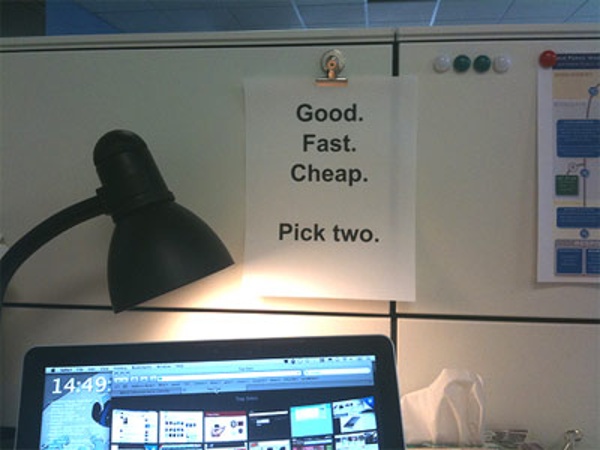
Better, faster, cheaper – you can only have two.
I’ve decided to touch a third rail of the current selling spirit: the ‘double tap’ — the process of leaving a voicemail immediately followed by an email.
I’m a little afraid of getting flamed on this one, but hey, what the heck.
Let me give you the scenario.
A sales rep is prospecting you and actually picks up the phone to reach out. Maybe you ignore them or maybe you’re away from your desk. They leave a voicemail, referencing that they’re also sending an email.
So, what happens next?
Scenario 1: In all likelihood, you check email before voicemail. Unless they’ve written a message that really grabs your attention, you delete it. You finally get around to checking your voicemail and delete that message without really listening to it. After all, based on their email, your impression is that you’re not interested.
Scenario 2: You get an email from your phone system notifying you of the new voicemail. You still read the (text) email first and then delete both as above.
Scenario 3: You listen to the voicemail first. Once again, unless it is compelling, you delete it. You notice the follow-up email and delete it as well.
Your brain is wired this way.
Two things are happening here. First, deleting feels good. There is a pleasure spike when shrinking the inbox, or to-do list. Second, similar back-to-back actions don’t require active thought. If this email isn’t interesting, neither will this voicemail be – and vice versa.
In all three scenarios, you’ve been interrupted twice in a very short span of time. Two ‘efficient’ touches for the seller (good), two interruptions for you (bad), and too easy to ignore (ugly).
Now, Sellers may argue their messages really are compelling. OK, I believe you! But I’ll bet you dollars to doughnuts that your ‘double tap’ messages are less researched, less targeted, and less memorable than any standalone ones. This is a case of 1 + 1 = .5.
Where does this leave us?
Look, I am not saying that you should never double tap. Reaching a prospect requires increasingly more attempts. However, there is a difference between using your touches to tell a story in a meaningful way and using your touches to harass.
Give your messages some breathing room, bring content into the mix, try social outreach, use video. Get creative!
So dear reader, what say you? If you are an Executive who receives sales calls, take the quick poll below. (Remember; answer how you would react, not how you want your sales teams to execute.)




There are many possible scenarios for how the double-tap plays out, but to save space, I’ll give you the most common one – for me, anyway. This will explain why I like the ‘double-tap.’
1. My cell phone plays ‘Hey Pocky Way,’ indicating that I have an incoming call, but it’s inconvenient for me to answer it. From the caller-id, I don’t know who is calling anyway. I press ‘ignore.’
2. Later, I see that there’s a voice message. It’s unfamiliar, but interesting. I want to follow up, but today is packed appointment-wise. I completely forget to follow up on the voice recording.
3. Sometime in the late evening, I catch up on email, and discover an email from the same person who left the earlier voice message. I appreciate the follow up, because it’s far easier for me to respond in ‘asynchronous’ mode anyway.
If the prospector/caller doesn’t get all chatty and wordy, and uses appropriate brevity throughout, I feel that this method for outreach is actually empathetic. I like it, it’s helpful. It conveys, ‘I’m not sure of the most convenient way for you to respond, but I’m making the effort to make sure it’s easy.’